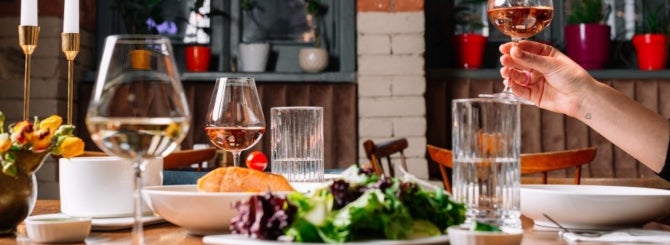
Over the past 15 years, the international press has been inundated with coverage of the Georgian Republic’s production of wine in qvevri.
For the uninitiated, it is an ancient terracotta pot, generally buried underground, that ages the wines in a temperature-controlled environment can give the country's whites additional layers of oxidation and what some call "complexity".
| Related stories: |
| Alice in Wine Wonderland |
| Archaeological Dig Confirms Georgia's Wine Heritage |
| The Russians Aren't Coming for Georgian Wine |
It is quite similar to the taste profile that amphora-aged wines have in Sicily and many other places, even if many Georgian producers don't appreciate the comparison. It often gives the white wines an amber color and a somewhat oxidized flavor, hence Stateside sommeliers' current fixation with these wines.
Lucky for those who prefer traditionally produced wines, which the Georgians call "European style", 95 percent of the country's total production is made this way according to the Tbilisi-based Wines of Georgia (WOG). This classic production method allows the flavors of these lesser-known varietals to shine through, without layering them in a lees-based haze with hints of oxidation that can obscure their true taste. Sadly, I had to go all the way to Georgia to better explore their taste profiles.
A recent trip to Tbilisi and the winegrowing region of Kakheti was focused on these wines and it did not disappoint. "Georgia is very proud of all sorts of wines," shares Irakli Kvantrishvili, the sommelier at the Tbilisi Marriott.
The basics
Saperavi is the great red grape of Georgia and, luckily for the country's producers, it is much easier to pronounce than many of the area's white varieties. Try saying Rkatsiteli – the nation’s top white grape – three times fast. To its advantage, in my book, Saperavi also shows less oxidative influence, than many whites, when aged in qvevri.
Part of the reason for this, according to Yanick Arakelov, co-owner and founder of the Orlando-based Silk Road Wines importer, it that "red wines might remain in qvevri with skins for up to eight weeks, compared to 24 weeks for amber wines". The sommelier Kvantrishvili agrees that Georgian reds show much less influence in terms of how they are aged, in great part because "when it comes to white wines, qvevri causes great changes, in taste, color, etc. As for red wines, the quevri changes the taste, color and other qualities slightly."
Ironically for a country that seems to have constantly gotten more attention for its reds, white grapes account for 75 percent of vineyards, according to WOG.
More than 500 indigenous varietals are grown in the county, according to WOG. Given the varietal diversity, the non-qvevri wines are picking up traction, according to Iva Davitaia, the owner of Restaurant Satatsuri in Tbilisi, although he notes that, because of the qvevri wines' popularity, 60 percent of his list focuses on these wines.
Many importers think that the style of non-qvevri wines encapsulate Georgia's terroir exquisitely, shares Silk Road's Arakelov. He adds that while this production method isn't as ancient as using qvevri, which "offers a different narrative and sets Georgian wines apart from others. As a result, non-qvevri wines, despite their quality, often get overshadowed by their qvevri counterparts in discussions and media coverage."
The standouts
The principal wine region of Kakheti is about a two-hour drive from Tbilisi. One of the area's top producers, the Tsinandali Estate, is often credited for introducing European winemaking techniques to Georgia, according to Arakelov. He adds that, once again, in the later 20th Century the Soviets prioritized "high-volume, consistent production over traditional methods, which led to the adoption of European-style winemaking techniques, including the use of stainless-steel tanks and oak barrels [primarily used to make European-style wines]".
The Tsinandali winery’s tasting room is in the swanky Radisson Collection Hotel, outside of Telavi, in the heart of Kakheti. It is the former residence of Prince Alexander Chavchavadze who revived the estate in the early 1800s.
The Prince Alexander Chavchavadze Tsinandali Estate 2022 was one of my absolute favorite whites of the trip. It is fresh, acidic with lovely notes of stone fruit, however this publication doesn't list anywhere it is distributed outside of Georgia and Australia unfortunately for the rest of us. The winery's 2021 Kisi, another indigenous white grape, has notes of peach flesh with a long finish. The winery's 2016 Saperavi Reserve is aging well with black cherry notes and good acidity.

A few of my other favorites include the Kakheti-based Shumi's Saperavi 2000 – fermented in qvevri, believe it or not. It is spicy, rich and full of black pepper and sumac. The Peradze Mtsvane 2020, a white also from Kakheti, was fresh, crisp and food-friendly. It is, sadly, available only in Georgia.
Will modern wines succeed?
If this impressive, and ancient, wine-making country wants to put itself on the international map it may well need to court less precocious wine drinkers and market its international-style wines to consumers, over critics and sommeliers. While many American drinkers love to be hand-led to a new discovery – the still-somewhat-out-there amber wines, col fondo or wines fermented on the lees – others will simply want to choose to enjoy a Georgian wine that seems familiar to them.
These are probably food-friendly wines made in an international style. Frankly, the country also might benefit from integrating some internationally known varietals into its lineup; although most of the producers I met are not likely to warm to the prospect.
A time-worn truth is that when American wine lovers can recognize and pronounce a varietal they are much more likely to buy it. It is a trick I learned early on in my career as an importer back in Seattle almost two decades ago. Put an obscure, but fantastic, wine from the Douro Valley on the shelf, made of Syrah and it will pique someone's interest. They might even come back to buy the Tinta Roriz, from the same producer regardless if they can't pronounce it, thereby extending their journey to the world of unique Portuguese wines.
One of the larger producers in Georgia, Lost Eden, is trying to make an easy-to-understand wine foray into the US market. The winery is currently making 20,000 cases a year – compare that to a very rough average of 8931 cases, according to WOG – and capable, according to its marketing executives, of making close to 100,000.
Its main red is Saperravi-based and the bottle is unique with raised glass outlines of vines running up and down its surface. One of my friends in the business said that the producers once wanted to be the Yellow Tail of Georgia: which certainly wouldn't lead to the winery setting its best foot forward. However, the few vintages I tasted of Lost Eden while in the country had too much residual sugar to make much of a splash with an experimental customer. I have heard that new vintages are less sweet.
On another fascinating marketing level, the winery is also presenting its wines as a blend, which is a mix of wines made in qvevri and in the international style. It is definitely a leap of faith to call it a blend. We will just have to see if the American market embraces that definition.
It is not clear if the incredibly proud Georgian winemakers will acquiesce to planting international grape varieties in their vineyards in the long term. It is sadly the same situation over the border with the Armenians, whose wine production also is estimated to date back to 6000 BC. However, pride before purchasing power isn't always the smartest approach.
It is truly sad that the indigenous grape varietals in the Caucusus region were cut off from making their way to western Europe. As a result, they are unfamiliar and hard to pronounce – with the exception of the slips-off-the-tongue Saperavi.
Maybe the smart producers in Georgia will eventually do their due diligence in creating fresh, clean European wines for the international consumer: perhaps with a touch of Merlot or something else US consumers can pronounce.






















